Castell Dinas Brân
Castell Dinas Brân is a medieval castle occupying a prominent hilltop site above the town of Llangollen in Denbighshire, Wales. The presently visible castle was probably built in the 1260s by Gruffydd Maelor II, a prince of Powys Fadog, on the site of several earlier structures, including an Iron Age hillfort.
| Castell Dinas Brân | |
|---|---|
| Near Llangollen, Denbighshire, in Wales | |
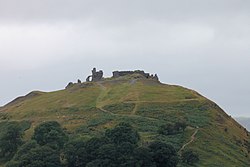 Castell Dinas Brân seen from Llangollen | |
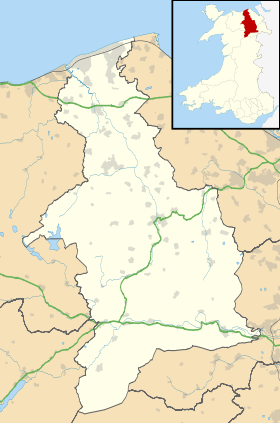 Castell Dinas Brân Location within Denbighshire | |
| Coordinates | 52.9792°N 3.1595°W |
| Site information | |
| Owner | Cadw |
| Open to the public | All year |
| Condition | ruinous |
| Site history | |
| Built | 13th century |
| Materials | stone |
| Fate | Abandoned in the 14th century |
| Events | Conquest of Wales |
Dinas Brân has been variously translated as the "crow's fortress" or "fortress of Brân", with Brân as the name of an individual or of a nearby stream.[1] An English name, "Crow Castle", has also been used since at least the 18th century.[2]
Toponym
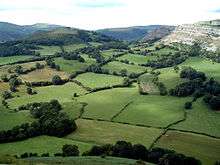
The name Dinas Brân has been debated since at least the 17th century. In modern times it is sometimes incorrectly translated as the City of Crows: the word dinas, "city" in modern Welsh, in Middle Welsh signifies a defended enclosure, while brân is the Welsh for "crow", singular, (plural: brain), suggesting a meaning "the crow's fortress".
An alternative theory is that Brân is a personal name. Humphrey Llwyd and William Camden both suggested it came from that of a Gaulish chieftain, "Brennus". There is a legend which says that Brân was a Cornish prince, the son of the Duke of Cornwall, while another suggests Brân could be named for King Brân Fendigaid (the Blessed) also called Bendigeidfran, a Celtic God who appears in both Welsh and Irish mythology. Camden also suggested the name was simply derived from the word bryn, "hill".[3]
A further suggestion is that Brân simply refers to a mountain stream of the same name which originated in the Eglwyseg Rocks and ran at the northern foot of the hill, a suggestion made by Thomas Pennant amongst others.[1] The 17th century scholar Edward Lhuyd, in Adversaria, confirmed that to his knowledge the name Brân came from "the brook of this name by Lhangollen".[4] As with several other streams in Wales,[5] the word Brân was applied to the brook apparently due to the black colour of its water.[3]
The castle is known in English as "Crow Castle".[3][1] This form of the name has been used since at least the 18th century, having been recorded in Gough's edition of William Camden's Britannia.[2] By the mid 19th century this was the form of the name said to be used by most of the inhabitants of Llangollen, where there was an inn of the same name.[1][3]
History
Iron age
A large hillfort was built on the hill around 600BCE during the British Iron Age. An earthen rampart - probably with a wooden palisade - surrounded a number of roundhouses. An extra deep ditch was cut to defend the gentler slopes on the southern side of the hill. This was one of many hillforts in this part of North Wales; for example Moel y Gaer near the Horseshoe Pass, Y Gardden in Ruabon, and on Foel Fenlli and Moel Arthur in the Clwydian Hills.[6]
Post Roman Britain
The earliest structure that might have been built at Dinas Brân is believed to have belonged to Elisedd ap Gwylog during the 8th century. Elisedd, who was a Romano British ruler during the Anglo-Saxon settlement of Britain is named on the Pillar of Eliseg and is considered one of the founders of the Kingdom of Powys, however, no archaeological evidence for any structure from this period has been found.[6]
Late Medieval period
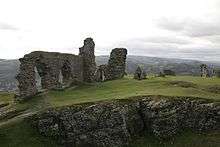
Dinas Brân may have been a fortification in the Kingdom of Powys. When its last Prince, Gruffydd Maelor, died in 1191, his kingdom was divided into Powys Fadog in the north and Powys Wenwynwyn in the south. His son, Madog ap Gruffydd Maelor, the lord of Powys Fadog, who founded Valle Crucis Abbey at Llantysilio in 1201 might have ruled from Dinas Brân.[7] Whatever structure existed at this site, it would have been a wooden fortification probably consisting of a wooden palisade surrounding a hall and other buildings. Early records attest to this early castle being destroyed by fire.
Following the destruction of the wooden castle, Gruffydd II ap Madog, Lord of Dinas Bran, the son of Madog ap Gruffydd Maelor, rebuilt Dinas Brân in stone sometime in the 1260s. At the time Gruffydd II ap Madog was an ally of Prince Llywelyn ap Gruffudd Prince of Wales, with Powys acting as a buffer state between Llywelyn's heartland of Gwynedd and England. Dinas Brân was one of several castles being built following the signing of the Treaty of Montgomery which had secured Wales for Llywelyn, free from English interference. The castle at Dolforwyn Castle near Newtown, which was ordered to be built by Llywelyn around the same time, has some similarities to Dinas Brân and may have been the work of the same master mason.[6] When Gruffudd died in 1269 or 1270, the castle was inherited by his four sons. Madoc the eldest son was senior but each of the sons may have had apartments at Dinas Brân.
The peace between Llywelyn and Edward I did not last long. In 1277 Edward launched the Conquest of North Wales from Chester. Two of Gruffudd's sons, Llywelyn and Madoc, quickly made peace with Edward. However, their surrender documents state the need to recapture Dinas Brân proving that the fortification was not under Madoc's control. Henry de Lacy, Earl of Lincoln was sent with forces from Oswestry to capture Dinas Brân. As soon as he had arrived he was told that the defenders of the castle, probably the younger brothers Owain and Gruffudd - who were still allies of Llywelyn Prince of Wales, had abandoned the castle and set it alight. The reason for this action is not clear but it may be that they had no confidence that they could defend the castle so did not want to let it fall intact to the English or their elder brother. Despite the fire, the castle was not badly damaged. The Earl Lincoln recommended to Edward that the castle be repaired and garrisoned. The castle was occupied by the English till at least the Treaty of Aberconwy when Llywelyn sued for peace and ordered some repair work was undertaken.[6]
When the war restarted in 1282, the history of the castle is not recorded. It may have been recaptured by the Welsh like many other castles in the early months of the war, but ultimately it fell to the English. After Madoc died: the three surviving brothers all fought for Llewelyn. Following the end of the war in October 1282 and the death of Llywelyn, most of Powys Fadog including the castle was granted to John de Warenne, Earl of Surrey. Rather than rebuild Dinas Brân, De Warenne choose instead to build a new castle by the River Dee at Holt on the Flintshire-Cheshire border. Dinas Brân was left to fall into ruin.[6]
Layout
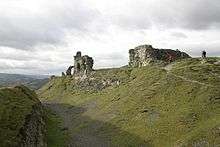
Dinas Brân has rectangular stone defensive walls with the longer sides running in an east-west direction. The northern wall is defended with the steep natural slope that falls sharply downards for several hundred feet. The walls on the gentler slopes on the southern and eastern sides are strengthened with an additional 20 feet (6.1 m) deep rock-cut ditch and counterscarp bank.[8]
At the south-eastern corner where the ditch is at its deepest stood the keep, which looks out onto a relatively easy approach to the castle from the River Dee. The two-storey structure00 would have been the strongest part of the castle, with its own defended approach through a narrow passage. Adjacent to the keep at the north eastern corner is a gatehouse, which was originally approached by a wooden bridge spanning the ditch. There is however almost no evidence remaining of the bridge and its supporting structure so that the exact configuration remains unclear. The bridge was also overlooked by the keep which allowed archers stationed there to guard the entrance. The Gatehouse had two towers either side of a decorated covered passageway into the castle courtyard.
The Great Hall is sited on the castle's southern side, where some of the more visible remains still stand. This was a large room used for dining and receiving visitors. Its much enlarged windows still look south across the valley and an arched gateway leads from the west end of the room to what was once the Kitchens in the basement of the adjacent apsidal ('D' shaped) tower. This tower, called the Welsh Tower, is a typical feature of Welsh castles of the period. It would have protruded from the castle wall into the defensive ditch and provided archers with a clear view of any attackers attempting to approach the southern wall. The tower had perhaps three storeys with living quarters on the upper floors. In the south western corner was a Postern gate. This was an additional exit from the castle, designed to be used in times of siege to allow the garrison to 'sally' out and attack their besiegers. Fragments of the arch remain as well as the slot for the door's drawbar.[6]
Originally, in the enclosed area of the castle there would have been stables, workshops, storage buildings and maybe a chapel but as these were built of wood nothing remains above ground level.[6]
In the 19th century there was a local tradition, recorded by Walter Hawken Tregellas, that at Tower Farm, about a mile from the castle, had formerly stood a tower that was an outwork of the castle defences.[9]
Legends and literature
Whilst the historical record for Dinas Brân is sparse, there are many myths and legends associated with the ancient site.
The popular Welsh song 'Myfanwy' was composed by Joseph Parry and first published in 1875. Parry wrote the music to lyrics written by Richard Davies ('Mynyddog'; 1833–77). The lyrics were probably inspired by the fourteenth-century love-story of Myfanwy Fychan of Castell Dinas Brân, and the poet Hywel ab Einion. That story was also the subject of the popular poem, 'Myfanwy Fychan' (1858), by John Ceiriog Hughes (1832–87) and of Felicia Hemans's poem 'Howel's Song', set to music by John Parry in his 'Welsh Melodies' (1822).
The castle first literary appearance is in a 12th-century historical document entitled "Fouke le Fitz Waryn," or "The Romance of Fulk Fitzwarine." In this tale the castle, named "Chastiel Bran," is referred to as a ruin during the early years of the Norman Conquest. The tale continues to tell of an arrogant Norman knight, Payn Peveril, who hears that no one has had courage enough to stay overnight inside the castle ruins, for fear of evil spirits. Payn and 15 'knightly followers' determine to stay the night. A storm blows up and an evil, mace-wielding giant called Gogmagog, appears. Payn defends his men against the attacks of the giant with his shield and cross, then stabs Gogmagog with his sword. As the giant is dying he tells of the earlier bravery of King Brân who had built the castle to try to defeat the giant. Despite King Brân's attempts against Gogmagog the King had been forced to flee and since then the giant had terrorised all the land around for many years. The giant also tells of a great treasury of idols buried at Dinas Brân which includes swans, peacocks, horses and a huge golden ox but dies without revealing its location.[10]
Preservation
The castle is a scheduled ancient monument owned and maintained by Denbighshire council with the assistance of Cadw. It is open all year round for visitors. Due to the exposed steep routes up to the castle, official advice suggests stout walking shoes and warm, waterproof clothing.
Notes
- Citations
- Tregellas 1864, p. 116
- Camden
- Evans 1804, p. 315
- Tregellas 1865, p. 51
- Pierce 1968, p. 268
- Kightly 2003
- King 1974, p. 39
- Wiles, John; Singer, R.; Fielding, S. (2017), "Castell Dinas Bran (ruined castle)", Coflein, Royal Commission on the Ancient and Historical Monuments of Wales, retrieved 10 January 2018
- Tregellas 1865, p. 54
- Oman 1989
- Bibliography
- Camden, William, Gough, Richard (ed.), Britannia, iii
- Evans, John (1804), Letters written during a tour through North Wales in the year 1798
- Kightly, Dr. Charles (2003), Dinas Brân Castle, Denbighshire County Council
- King, D. J. Cathcart (1974), "Two Castles in Northern Powys: Dinas Bran and Caergwrle", Archaeologia Cambrensis, CXXIII: 113–139
- Oman, Charles W. C. (1989) [1926], British Castles, Dover Books
- Pierce, G. Owen (1968), The place-names of Dinas Powys Hundred, University of Wales Press
- Tregellas, Walter H. (1864), "Castell Dinas Bran" (PDF), The Archaeological Journal, 21: 114–120, doi:10.1080/00665983.1864.10851279

- Tregellas, Walter H. (1865), "Castell Dinas Bran near Llangollen, Denbighshire", Archaeologia Cambrensis: 49–58

- Further reading
- Reid, Alan (1973), The Castles of Wales, ISBN 0-85097-185-3
- Roseveare, Martin J. (2017), Castell Dinas Bran, Llangollen, Denbighshire: Geophysical Survey Report (PDF), Tigergeo and the Castle Studies Trust
